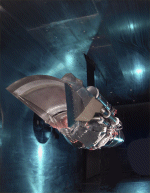NASA Tests Novel Supersonic Inlet

An advanced high-speed inlet for propulsion systems to power air transport vehicles at supersonic speeds has completed testing at NASA's Glenn Research Center, Cleveland.
Tests during the last two weeks helped refine the inlet's performance through adjustments to the inlet geometry. "Compared to typical inlets in this operating range, tests showed high pressure recovery, low cowl drag, reduced complexity, increased safety, significant manufacturing cost reduction and weight, as well as increased efficiency," said David Lam, project manager for the inlet's tests.
With potential applications to supersonic cruise vehicles, NASA has vigorously pursued an alternative to previously used inlet designs.
Nearly 75 hours of testing of the inlet late last year confirmed the advantages of the Parametric Inlet. Unlike typical inlets for supersonic cruise that rely on a mix of external and internal compression, this inlet accomplishes all of the supersonic compression externally. Comparable performance to typical inlets was shown to be possible, with the added benefits of relatively lower weight and the elimination of unstart, which is a recurring problem in propulsion systems with mixed compression inlets.
Unstart occurs in mixed compression supersonic inlets due to the mismatch between the inlet air supply flow and the engine required flow resulting in shock waves that are violently expelled from the engine. This often results in compressor stall combustor blowout and large increases in drag, which in turn decreases efficiency. Additional aircraft structure and larger control surfaces are necessary to allow for the possibility of inlet unstart.
"NASA's tests of its Parametric Inlet have proven that this type inlet can operate safely in the flow regime normally reserved for mixed compression inlets," said Dave Davis, inlet test research engineer at Glenn.
Four years ago, conceptual design of the Parametric Inlet was jointly conceived by Boeing Aircraft, Seattle, Wash., and TechLand Research, Inc., North Olmsted, Ohio, which received NASA funding through its Small Business Innovative Research (SBIR) program. The inlet came to be known as the Parametric Inlet due to the wide range of geometric variables designed into it. After competing the three phases of the SBIR process in designing the inlet, Glenn took the lead in refining the aerodynamic lines and mechanical design, with help from TechLand. Testing of the Parametric Inlet was funded by NASA's Vehicle Systems Program. Additional funding for testing was provided by the Air Force.
For more information on other aeronautics work at NASA on the Internet, visit:
www.ueet.nasa.gov/
www.grc.nasa.gov/WWW/AERO/base/psbase.htm
A photo of the Parametric Inlet can be found at:
www.grc.nasa.gov/WWW/PAO/press … 2004/04-038addm.html
For the original release visit www.grc.nasa.gov/WWW/PAO/pressrel/2004/04-038.html
















